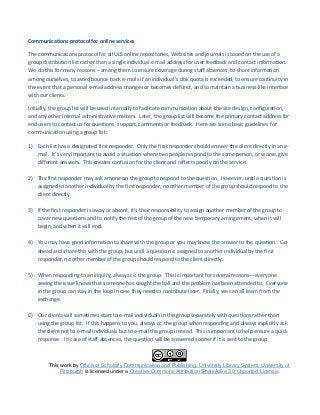
Library as publisher handout 6-communications protocol-cc_by-sa
- 1. Communications protocol for online services The communications protocol for all ULS online repositories, Web sites and journals is based on the use of a group distribution list rather than a single individual e-mail address for user feedback and contact information. We do this for many reasons – among them to ensure coverage during staff absences, to share information among ourselves, to avoid bounce-back e-mails if an individual’s disk quota is exceeded, to ensure continuity in the event that a personal e-mail address changes or becomes defunct, and to maintain a business-like interface with our clients. Initially, the group list will be used internally to facilitate communication about the site design, configuration, and any other internal administrative matters. Later, the group list will become the primary contact address for end users to contact us for questions, support, comments or feedback. Here are some basic guidelines for communication using a group list: 1) Each list has a designated first responder. Only the first responder should answer the client directly in an e- mail. It’s very important to avoid a situation where two people respond to the same person, or worse, give different answers. This creates confusion for the client and reflects poorly on the service. 2) The first responder may ask anyone on the group to respond to the question. However, until a question is assigned to another individual by the first responder, no other member of the group should respond to the client directly. 3) If the first responder is away or absent, it’s their responsibility to assign another member of the group to cover new questions and to notify the rest of the group of the new temporary arrangement, when it will begin, and when it will end. 4) You may have good information to share with the group or you may know the answer to the question. Go ahead and share this with the group, but until a question is assigned to another individual by the first responder, no other member of the group should respond to the client directly. 5) When responding to an inquiry, always cc: the group. This is important for several reasons—everyone seeing the issue knows that someone has caught the ball and the problem has been attended to. Everyone in the group can stay in the loop in case they need to contribute later. Finally, we can all learn from the exchange. 6) Our clients will sometimes start to e-mail individuals in the group separately with questions rather than using the group list. If this happens to you, always cc: the group when responding and always explicitly ask the client not to e-mail individuals but to e-mail the group instead. This is important to help ensure a quick response. In case of staff absences, the question will be answered sooner if it is sent to the group. This work by Office of Scholarly Communication and Publishing, University Library System, University of Pittsburgh is licensed under a Creative Commons Attribution-ShareAlike 3.0 Unported License.
